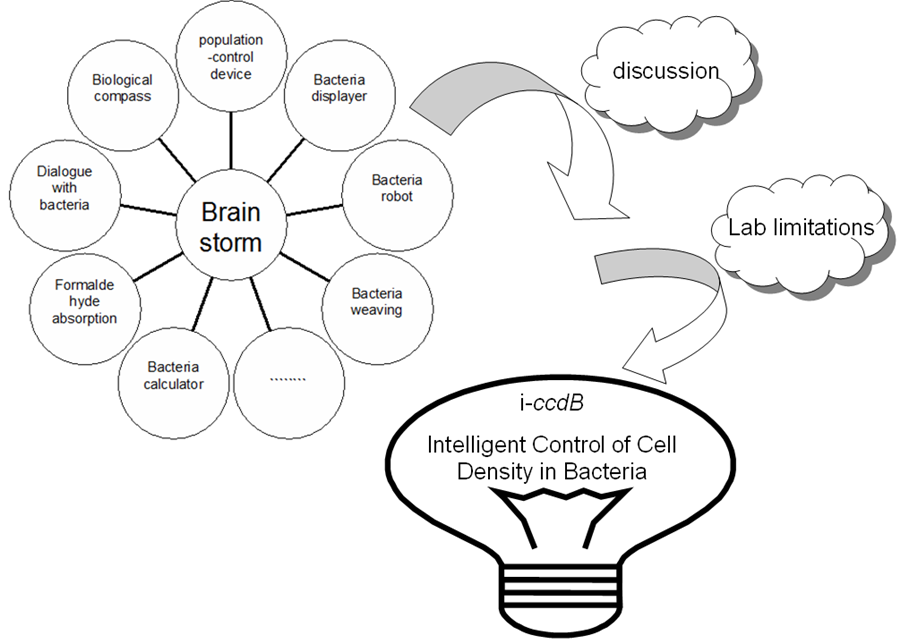Team:XMU-China/Project/Appoach
From 2011.igem.org
(Difference between revisions)
(→The Final Product) |
|||
| (One intermediate revision not shown) | |||
| Line 5: | Line 5: | ||
One day, our instructor had Pu’er tea in his office and said to us that the tea wasn’t bitter at all. Instead, it tasted sweet because it had been treated with some special methods. One of team member found it an interesting topic. So she referred to some books for information about the fermentation of the Pu’er tea. She found that the concentration of bacteria in the fermentation process was the most important factor of determining the taste of the tea. The prevailing method used for controlling the concentration of bacteria is by controlling the concentration of the medium. We came up with the idea that fermentation technology can be simplified if bacteria can maintain at the optimum concentration by itself. | One day, our instructor had Pu’er tea in his office and said to us that the tea wasn’t bitter at all. Instead, it tasted sweet because it had been treated with some special methods. One of team member found it an interesting topic. So she referred to some books for information about the fermentation of the Pu’er tea. She found that the concentration of bacteria in the fermentation process was the most important factor of determining the taste of the tea. The prevailing method used for controlling the concentration of bacteria is by controlling the concentration of the medium. We came up with the idea that fermentation technology can be simplified if bacteria can maintain at the optimum concentration by itself. | ||
| + | |||
| + | We are inspired by a paper published on natrue[3]. And we thought that we could also use the method of synthetic biology to solve the problems which could be solved by traditional biology method and perhaps we could do even better and make great improvements. So we came up with the idea of making a series bacteria population-control devices. | ||
| Line 39: | Line 41: | ||
| - | == | + | ==Reference== |
[1] http://en.wikipedia.org/wiki/Pu-erh_tea | [1] http://en.wikipedia.org/wiki/Pu-erh_tea | ||
| + | |||
[2] Baldwin T, Devine JH, Heckel, RC, Lin, JW, Shadel GS. The complete nucleotide sequence of the lux regulon of Vibrio fischeri and the luxABN region of Photobacterium leiognathi and the mechanism of control of bacterial bioluminescence[J]. Journal of Bioluminescence and Chemiluminescence, 1989, 4(1): 326-341. | [2] Baldwin T, Devine JH, Heckel, RC, Lin, JW, Shadel GS. The complete nucleotide sequence of the lux regulon of Vibrio fischeri and the luxABN region of Photobacterium leiognathi and the mechanism of control of bacterial bioluminescence[J]. Journal of Bioluminescence and Chemiluminescence, 1989, 4(1): 326-341. | ||
| + | |||
[3] You L, Cox RS, Weiss R, Arnold FH. Programmed population control by cell-cell communication and regulated killing[J]. Nature, 2004, 428(6985): 868-871. | [3] You L, Cox RS, Weiss R, Arnold FH. Programmed population control by cell-cell communication and regulated killing[J]. Nature, 2004, 428(6985): 868-871. | ||
| + | |||
[4]Philippe B,Martine C.Cell killing by the F plasmid CcdB protein involves poisoning of DNA-topoisomerase II complexes[J].Molecular Biology,1992,226(3):735-745. | [4]Philippe B,Martine C.Cell killing by the F plasmid CcdB protein involves poisoning of DNA-topoisomerase II complexes[J].Molecular Biology,1992,226(3):735-745. | ||
Latest revision as of 03:59, 29 October 2011
 "
"


